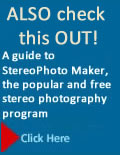One of the first things people ask when they find out you are taking stereo images is "How do you see them in 3D?" This is as good a reason as any to start this book with the end result—displaying and sharing the stereo images you capture.
There are a number of ways to view the two related images in a stereo pair but all of the techniques have one thing in common— to get the 3D effect you view each of the images with a different eye. When you do this in just the right way the brain fuses the two 2D images into a single 3D image. You can do this with a pair of still images or pairs of frames displayed one after another in movies.
Viewing methods can be passive, active and autostereoscopic. Here is a brief summary of each of the viewing methods discussed in this chapter.
SOME THINGS NEVER CHANGE
One of the best things about stereo photography is that capturing and viewing stereo pairs are independent activities. You can view the same stereo pairs with all of the available techniques, and any that are developed in the future.
PASSIVE VIEWING
Passive viewing is done without glasses (called
freeviewing) or with glasses that contain no electronic components. This category
includes the following technologies.
- Separation based on side-by-side images. With a little practice you can place the images in a stereo pair side-by-side and see the 3D effect without using glasses or other viewing devices—a process called freeviewing. There are also many viewing devices such as the Holmes viewer and it's modern
descendents that make it easier to see the 3D effect. ViewMaster reels and viewers are a variation of this technology.

A side-by-side stereo pair.
- Separation based on polarization. Passive glasses using polarized lenses can direct superimposed or sequential images to the correct eyes based on their polarization. This technology is used for viewing most movies and an increasing number of 3D TV sets and computer monitors.
- Separation based on colors (spectral separation). Passive glasses with colored lenses can direct the superimposed images to the correct eyes based on their colors. Examples of this technology include anaglyphs and Dolby 3D movies. Anaglyphs are popular on the Internet, in printed materials and are for movies that are to be displayed on 2D TV sets.
ACTIVE VIEWING
Active systems use glasses that contain electronic components to direct the images to the correct eyes.
- Separation based on timing. Active shutter glasses can direct the left and right images to the left and right eyes by opening and closing shutters in the eyepieces in synchronization with the stereo pairs being flashed on the screen. This was the first technology to be widely used for home TV sets
and 3D computer systems.
- Separation based on separate feeds. Head mounted displays, also called video glasses, personal media viewers, or virtual retinal displays have separate LCD screens in each eyepiece so left and right images can be fed to them separately. This technology is used in video games and high-end applications.
MARTIAN 3D
James Cameron, perhaps best known for his 3D movie Avatar, is working with NASA and Malin Space Science Systems to mount a 3D camera on the Mars Science Laboratory rover, named Curiosity. The camera will send both stereo pairs and stereo movies back for viewing.
AUTOSTEREOSCOPIC VIEWING
Autostereoscopic systems require no glasses or other viewing devices. By cutting a pair of stereo images into thin slices and then interleaving them, lenticular lenses or parallax barriers on top of the screen can direct alternate slices to different eyes. These displays are increasingly being used in small handheld devices, 3D photo frames, and small TV sets. Lenticular technologies are also used to create 3D lenticular prints as you’ll see in Chapter 2.

An audience wearing anaglyph glasses. Susan Pinsky & David Starkman from Reel 3-D are in the front row. The photo was taken by David Burder (lower left). Courtesy of Reel 3-D Enterprises and David Burder.

